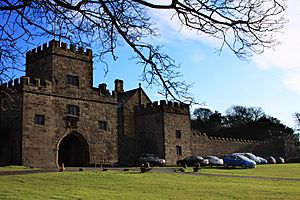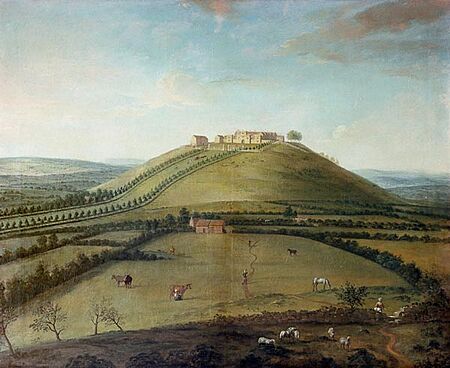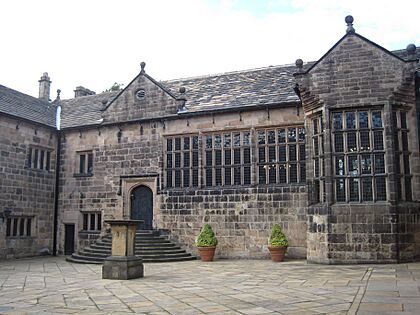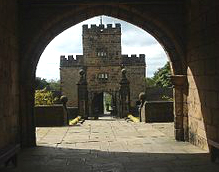Hoghton Tower facts for kids
Quick facts for kids Hoghton Tower |
|
|---|---|
 |
|
| Location | Hoghton, Lancashire, England |
| OS grid reference | SD 623,264 |
| Elevation | 560 ft (170 m) |
| Built | c, 1560–65 |
| Built for | Thomas de Hoghton |
| Restored | 1862–1902 |
| Restored by | Sir Henry de Hoghton Sir Charles de Hoghton |
| Architect | Paley and Austin, James Bertwistle, Robert Dudley Oliver |
|
Listed Building – Grade I
|
|
| Designated | 22 October 1952 |
| Reference no. | 1072532 |
Hoghton Tower is a strong, old house called a fortified manor house. It is located about 1 kilometer east of the village of Hoghton in Lancashire, England. The house sits on top of a hill, which is the highest point in the area.
It is named after the de Hoghton family, who have owned the land since at least the 1100s. The house you see today was built around 1560–1565. Hoghton Tower was damaged during the English Civil War in the 1600s and later fell into ruin. However, it was rebuilt and made bigger between 1862 and 1901.
The house is a very important historic building, listed as Grade I. The Great Barn on its grounds, built in 1692, is also Grade I listed. Two other buildings on the property are listed as Grade II. Hoghton Tower and its gardens are open to visitors at certain times. A charity called the Hoghton Tower Preservation Trust takes care of the property.
Contents
History of Hoghton Tower
The Hoghton Tower estate is on a hill at the southwest end of the Pendle Hill area. The de Hoghton family has owned this land for a very long time, since at least the 1100s. The current building was constructed around 1560–1565 for Thomas de Hoghton. It replaced an older house that was there before. Some people think there might be a connection to William Shakespeare through Alexander Hoghton, who died in 1581, but this is not certain.
King James I's Visit
King James I visited Hoghton Tower from August 15 to 18, 1617. He came with many people, and important local families joined him. A painting by Victorian artist George Cattermole shows this visit. On August 16, the King visited the alum mines owned by Sir Richard Hoghton, 1st Baronet. While hunting, he tried to shoot a stag but missed.
During the King's visit, there was a disagreement in Lancashire. Some people, called Puritans, wanted strict rules about what could be done on Sundays. Others, including many wealthy families who were Roman Catholics, wanted more freedom. The King heard about this problem. He later issued a statement, which became known as the Declaration of Sports. This statement made it easier for people to enjoy sports and fun activities on Sundays across the country.
The Sirloin Steak Myth
A list of food served during the King's visit on August 17 and 18, 1617, still exists. This list also names the cooks and kitchen staff. This is where a famous, but untrue, story comes from. The story says that King James I was so impressed by a piece of beef that he "knighted" it "Sir Loin." However, there is no real proof for this story. Most experts agree it is just a myth. A pub in a nearby village was even named after this made-up event.
Damage During the Civil War
In 1643, Hoghton Tower was damaged during the English Civil War. Forces loyal to Parliament, sometimes called Roundheads, attacked the house in February 1643. At that time, only about 30 to 40 soldiers were defending Hoghton Tower. They gave up on February 14.
When the Roundheads entered the house, a gunpowder storage area in the old pele tower exploded. This tower was located between the two courtyards. The explosion killed over 100 Parliamentary soldiers. Because of this, the central tower was never rebuilt.

Later History and Restoration
From 1662, for over 100 years, Hoghton Tower was a place for nonconformist church services. Sir Richard (1616–1678) became a Presbyterian, and by 1664, the house was a center for both Independents and Presbyterians in the Blackburn area. It is said that John Wesley and Charles Wesley, famous religious leaders, preached at Hoghton Tower.
Between 1692 and 1702, Sir Charles de Hoghton repaired and rebuilt parts of the house. King William III often visited Hoghton Tower because he was a friend of Sir Charles. Later, Sir Henry, the fifth baronet, asked artist Arthur Devis to paint a picture of the house in 1735.
In 1768, the de Hoghton family moved to another property and rented out Hoghton Tower. By the mid-1800s, the house was in ruins. In 1862, Sir Henry de Hoghton, the 9th Baronet, inherited the estate and decided to restore the house. The famous writer Charles Dickens visited in 1867. Even though the house was falling apart, it inspired him to write his 1868 short story George Silverman's Explanation, where Hoghton Tower is an important setting.
The architects Paley and Austin from Lancaster worked on the restoration starting around 1876. They restored rooms, including the banqueting hall. After Sir Henry died, his brother Charles continued the work. By 1880, the gateway tower and walls were restored, and a new entrance lodge, kitchen, and other changes were made. Later, from 1896 to 1901, architect Robert Dudley Oliver added more rooms, including a smoking room, a billiards room, and a large drawing room, which is now used as a ballroom.
Architecture of Hoghton Tower
Hoghton Tower is built from sandstone with stone slate roofs. It has two courtyards. You enter the outer courtyard from the west side through a large gatehouse. The gatehouse has battlements (like a castle wall) and two floors, with a central tower that is even taller. Above the archway, there is a carving from the 1500s of Samson and the Lion. On each side of the gateway, walls with battlements lead to square corner buildings called pavilions, which also have battlements.
Buildings from different time periods stand on the north and south sides of the outer courtyard. This courtyard has two levels, with the eastern part being higher. Between the two levels is a wall with steps leading up to a gateway. This gateway has beautiful wrought iron gates from the 1700s. In the northeast corner of the courtyard is a well house from the 1600s. This is where the original tower, destroyed in the Civil War, used to stand.
The inner courtyard has a west gateway. On the north side are the great hall and kitchen. State rooms are on the east side, and living rooms are on the south and west sides. Most of the inner courtyard buildings have two floors. At the northeast corner is a porch, which was once a chapel. Large bay windows stick out from the north and south sides of the great hall.
Inside Hoghton Tower
The house has a Tudor well house with a well that is about 37 meters deep. It used to have a horse-drawn pump to bring up water. The State Bed in the State Bedroom was made in the mid-1500s. The ballroom was decorated in the 1800s. The banqueting hall has 4,000 Flemish stained glass panes, which are pieces of colored glass. The house is also known to have three priest holes, which were secret hiding places for priests during times of danger.
Gardens and Grounds
You reach Hoghton Tower by a long, straight road that goes east from the A675 road. This road passes through two gate piers about 180 meters west of the house. Between these gates and the entrance to the outer courtyard is a grassy area called the Tilting Ground. This area is surrounded by a wall on the south side and the Great Barn on the north.
On the east side of the house is a walled garden called the Wilderness. On the south side are smaller walled gardens, including the Rose Garden and the Rampart Garden. The Great Barn is made of sandstone with a slate roof and includes a cart house. It was built in 1692 and has decorative ball shapes on its roof peaks. To the northwest of the house are the coach house and stables, also made of sandstone, from the 1600s or early 1700s. A small dome was added to it in the 1800s. At the start of the drive on the main road is the lodge designed by Paley and Austin in 1878.
Hoghton Tower Today
Hoghton Tower and the Great Barn were officially recognized as Grade I listed buildings on October 22, 1952. The coach house, stables, and the gate piers on the drive are listed as Grade II. The gardens are also listed as Grade II on the National Register of Historic Parks and Gardens.
In 1978, the Hoghton Tower Preservation Trust was created as a charity. Its goal is to protect the house and encourage learning and research about it. The trust earns money by charging visitors an admission fee, holding events, offering holiday places to stay, and renting out the venue for weddings, filming, and other events. The house and gardens are open to the public at certain times. Inside the house, there is a collection of dolls' houses. There is also a tea room and a gift shop. You can even stay overnight in a converted former garrison building.
Hoghton Tower has been used as a location for filming movies and TV shows. Parts of the second series of Last Tango in Halifax (2012) were filmed here. The 2005 drama Casanova, starring David Tennant, was also partly filmed at the house.
Since 2015, Elena Faraoni, who is the daughter of the current 14th baronet, has been leading the team that manages the house and estate. Some people say that Hoghton Tower is the "third most haunted house in England."
See also
- Grade I listed buildings in Lancashire
- Listed buildings in Hoghton
- List of non-ecclesiastical works by Paley and Austin



